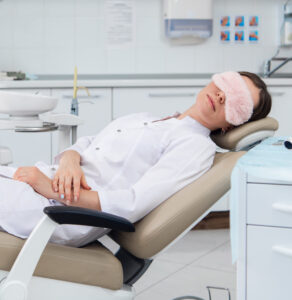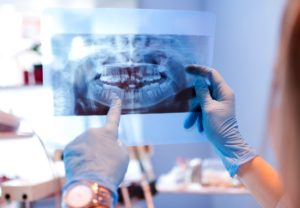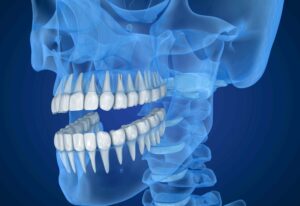Header logo
header top contact widget
Dental Fears
Don’t Allow Dental Fear or Anxiety To Ruin Your Smile
Posted on Aug 23, 2023 by William J. Claiborne, DDS MS
It’s a proven fact that your oral health – the wellness of your teeth and gum tissues – is an influencing contributor to your overall health. For decades, researchers have studied the concerning risks, and alarming connections, between oral health and a number of serious diseases in the body.
The leading culprit in this scenario are the bacteria of advanced gum disease, known as periodontitis. Gum disease breeds bacteria that are inflammatory in makeup. Once they enter the bloodstream (through tears in disease oral tissues), studies have found these potent bacteria can trigger the onset of serious diseases, such as:
• Heart disease
• Stroke
• Alzheimer’s disease & Dementia
• Some cancers (including lung and pancreatic)
• Pre-term babies
• Diabetes
• Arthritis
• High blood pressure
• Erectile Dysfunction (ED)
As research continues, more and more findings are bringing to light just how connected the mouth is to the efficient operation of the immune system. During the Covid pandemic, it was well publicized that those most vulnerable to the virus were those who were immune compromised.
One study, conducted between February and July 2020, analyzed two groups of 568 total patients with severe COVID-19 complications (death, ICU admissions or assisted ventilation). Periodontal conditions in the two groups were analyzed. Of the patients studied, those with periodontitis were three times more likely to experience COVID‐19 complications including death, ICU admission, and the need for assisted ventilation.
For years, the cost of dentistry has been credited for preventing millions of American adults from having regular dental care. This was recently studied in a nationally representative survey of 5,682 adults. In this, researchers looked at knowledge, attitudes, experiences, and behaviors related to oral health.
Results from the survey show that lack of insurance is a leading reason for avoiding dental care or delaying recommended care (often until something becomes so painful that the individual is forced into a dentist’s chair seeking relief).
The study showed that 16% of adults without dental insurance admitted that they had not seen a dentist in more than five years compared to just 5% of adults with dental insurance. Forty percent of adults without dental insurance reported cost was the reason they hadn’t visited the dentist in the past two years, compared to 14% of adults with dental insurance.
Yet, excruciating pain from a dental problem can be the impetus for setting aside the cost. The same is true for people who have fear or anxiety associated with dental care.
About 36% of people in the U.S. have a fear of dental treatment, with 12% having an intense fear, known as dentophobia. Dental phobics are people who avoid going to the dentist at all. Dental fear is more common in females than males, with an estimated 3% of men and almost 5% of women having dentophobia.
Reasons for these fears include:
– Fear the anesthetic will not work or be sufficient to fully numb the pain
– Blood makes some people feel afraid or panicky about bleeding during a dental procedure.
– People may fear choking or gagging and not being able to breathe or swallow.
– For individuals who have had a poor experience with a dentist in the past, they may associate negative feelings with their dentist.
– Feeling pain from the procedure or recovery
– Some people are highly fearful of needles.
– The noise from drills and dental instruments used by a dentist or dental hygienist can create high levels of anxiety for some people.
– The same is true when it comes to certain smells that arise during dental treatment.
New Study Links Periodontitis and COVID‐19 Complications
At our Asheville NC periodontal dental office, we take patient comfort very seriously, and that goes for all patients at every appointment. We find that many patients have developed severe gum disease or had tooth loss because they were afraid of going to a dentist. This prevents people from having regular dental care, which allows small problems to become worse ones.
Many with dental fear or dentophobia avoid going to the dentist for years. And, these feelings may be more common than you know. When dental anxiety, dental fear and dentophobia are combined, it affects an estimated 70% of American adults. This unfortunate statistic is a likely reason for the high percentage of adults who suffer with some level of periodontal (gum) disease – over 47%.
As a Periodontist, my staff and I work diligently to pamper patients from the moment they enter. For certain procedures as well as for patients who prefer the addition of sedatives, we offer oral sedation as well as I.V. sedation (twilight sleep).
Oral sedation is a pill that helps patients relax. It also has an amnesiac effect, leaving most with little or no memory of treatment afterward.
I.V. sedation places the patient in a deeper sleep state, also erasing memory of the procedure. It is administered by a doctor of anesthesiology, overseen by Dr. Brad Stone, a Medical Doctor (MD) and a board certified Anesthesiologist & Pediatric Anesthesiologist.
https://www.biltmoreperiodontics.com/comprehensive-care-team/
With both sedation options, patients are closely monitored with advanced safety equipment throughout treatment.
If fear has caused you or someone you know to avoid dental visits, please arrange a consultation with us. In our Western NC periodontal dental office, you’ll find a warm, respectful atmosphere where your concerns are understood. During this time, we can discuss comfort options that may be best for your individual needs along with estimated costs.
Call 828-274-9440.
Beware of Hidden Contributors to Gum Disease, Tooth Loss
Posted on Aug 19, 2023 by William J. Claiborne, DDS MS
Decades ago, oral health was something many people took lightly, often waiting until something hurt to see a dentist. The fierce pain of a cavity or abscess or the sharp jolt of something hot or cold on an area of gum recession were motivators to for a dental visit.
However, Americans are now realizing how very important their oral health is in how it relates to overall health.
The correlation lies with bacteria that live within the gum tissues. While all mouths contain “good” and “bad” bacteria, research has determined that the bad type can cause problems within and outside of the mouth.
The bad bacteria are inflammatory. An accumulation of these inflammatory bacteria are what lead to periodontal (gum) disease. Gum disease is the nation’s leading cause of adult tooth loss. Additionally, advanced periodontal disease – periodontitis – can trigger or even worsen serious health condition far beyond the mouth.
Although gum disease can begin without any obvious symptoms, once it exists, progression occurs in three stages, which are:
• Gingivitis – As the initial stage of gum disease, inflammation is triggered by plaque buildup at the gum line. When daily brushing and flossing fail to thoroughly remove plaque, toxins form that cause irritation to the gum tissues. Once signs emerge, they may include seeing blood in the sink when brushing or having sore, swollen gums. At this stage, however, damage may be reversed with prompt response.
• Periodontitis – As the disease advances, the bone structures and fibers that support teeth are damaged by the destruction of infectious oral bacteria. At this stage, inflamed gums form pockets below the gum line, filling with bacteria-laden plaque.
• Advanced Periodontitis – In the advanced stage of gum disease, fibers and bone supporting natural teeth are destroyed. This can cause teeth to shift or loosen, requiring aggressive treatment to prevent tooth loss. Eventually, some teeth may require removal.
As devastating as tooth loss can be to one’s overall health, the bacteria of gum disease can enter the bloodstream. Research has shown this infectious bacteria can trigger inflammatory reactions elsewhere in the body, correlating to heart disease, stroke, high blood pressure, some cancers (including lung and pancreatic), diabetes, arthritis, impotency, preterm babies, Alzheimer’s disease and more.
Obviously, people should be highly-committed to the care of their oral health. Yet, statistics in America along these lines are not impressive. The Center for Disease Control’s Division of Oral Health cites that 1 out of every 2 American adults 30 and over has periodontal disease. They also shared that periodontal disease is higher in men than women (56.4% vs. 38.4%) with high prevalence rates among smokers (64.2%) and adults 65+ (70.1%).
In addition to your twice-a-year dental check-ups and cleanings, there are other ways to support oral wellness between visits. One is in keeping the mouth moist, supporting sufficient saliva flow.
When saliva flow is insufficient, bacteria are able to accumulate and multiply rapidly. In addition to oral dryness as a part of the aging process, contributors can be consuming alcoholic beverages, caffeine, and as a side effect of many medications (both OTC and Rx).
One reason to keep your dental professionals aware of ALL the medications your take is in how they can interact with certain procedures, including numbing agents. For example, medications to reduce blood clotting, which lowers your risk for stroke and heart disease, can cause bleeding problems during oral surgery or periodontal treatment.
For those who take medications that help to strengthen bones, these have been associated with a rare but serious condition called osteonecrosis of the jaw. Simply put, it refers to death of the bone. The risk of these prescriptions is greater for those administered by injection or intravenously.
Osteonecrosis of the jaw commonly occurs after dental procedures (tooth extraction, implant placement). Over 90% of those who have experienced osteonecrosis are those who have taken the medication in repeated high doses due to cancer or other diseases.
However, 10% who experienced osteonecrosis were taking much lower doses, mostly intended to treat osteoporosis.
Certain medications also affect the ability to taste, including cardiovascular agents, central nervous system stimulants, non-steroidal anti-inflammatory drugs, respiratory inhalants and nicotine skin patches.
Some medications can also cause the development of oral sores, inflammation or discoloration of gum tissues in the mouth. These oral sores or discolorations may arise from taking medications for blood pressure, oral contraceptives and chemotherapy agents.
Dry mouth is a common side effect of a wide variety of medications, including prescriptive and over-the-counter. These include antihistamines, decongestants, painkillers, high blood pressure medications, muscle relaxants, drugs for urinary incontinence, anti-depressants and many others. Drying causes the soft tissues in the mouth to become inflamed and makes you more susceptible to infection. When saliva flow is depleted, your risk for tooth decay and gum disease increases.
Supplements that may seem unconnected to your oral health can actually effect your care more than you realize. It is important for your dentist to know if you take…
• Ginkgo biloba or evening primrose – These herbs can reduce your blood’s ability to clot, possibly leading to excessive bleeding during and/or after a dental procedure.
• St. John’s Wort – This herb, which is often taken to reduce anxiety, can interfere with the metabolism of other medications, including sedatives, antibiotics and anti-inflammatory drugs such as prednisone and Decadron. When combined with St. John’s Wort, these drugs can be less effective. On the other hand, narcotics such as codeine, Vicodin and oxycodone can become more potent when taken with St. John’s Wort. This can lead to sleepiness, lethargy and dizziness.
• Valerian – This herb has mild sedative effects. If your dentist prescribes drugs for anxiety or painkillers containing codeine, the effects of both together are greatly accentuated. This can lead to severe sleepiness, lethargy and dizziness that can last into the next day.
• Calcium and magnesium – When these supplements are combined with certain antibiotics, they can decrease the antibiotics being properly absorbed. This can compromise your ability to fight off infection.
As a periodontal specialist, I find that most cases of dry mouth are due to factors that can be easily controlled with simple changes. If you have delayed or avoided dental care, call 828-274-9440 to request a consultation, or begin with a thorough examination in our Asheville periodontal office.
And, if you are experiencing signs of gum disease, please know this disease will only worsen without treatment. The sooner you have treatment, the less involvement your treatment will likely be.
We offer the latest techniques, technology, and skills while always making patient comfort a top priority. If dental fear or anxiety are concerns, please make us aware of this when you call or at your initial appointment. In addition to our standard comfort features, we offer Oral and I.V. sedation (“twilight sleep”).
Six Reasons To Have Your Dental Implants Placed By A Periodontist
Posted on Jul 12, 2023 by William J. Claiborne, DDS MS
A periodontist is a dental specialist who is often in the background of various dental procedures. Yet, we are in the forefront when it comes to specialized skills that support specific treatment needs.
 Most patients are referred to our Asheville periodontal dental office by general dentists and dental specialists to provide certain aspects of dental treatment, which may involve our skills in cosmetic dentistry, dental implants, and treating all stages of gum disease.
Most patients are referred to our Asheville periodontal dental office by general dentists and dental specialists to provide certain aspects of dental treatment, which may involve our skills in cosmetic dentistry, dental implants, and treating all stages of gum disease.
A periodontist has advanced training to properly diagnose and treat all stages of periodontal (gum) disease (including gingivitis and periodontitis) as well as placement of dental implants. In addition, periodontists are particularly skilled in performing cosmetic periodontal procedures to repair gum-related disparities such as a “gummy smile” or varying gum arches that “jumble” a smile line.
A periodontist receives an additional 3 years of training after 4 years of undergraduate school and 4 years of dental school. This long, rigorous pursuit of the periodontal specialty requires the individual to be highly committed to the advanced care he or she will provide. It is our goal to help people achieve good oral health, a confident smile they love to share, and prevent tooth loss that can result from diseases of the gums.
Dental implants are now seen as the preferred option for tooth replacement. They come in over 40 different types designed to accommodate various challenges and preferences. But, why should you have your dental implants chosen and placed by a periodontist? After all, some dentists perform this in addition to their general dentistry services.
Below are 6 reasons our dental implant patients have particular advantages…
(1). With specialized skills, a periodontist is especially respectful to oral tissues as sensitive layers that have an important role in the appearance of a smile and the health of teeth. Utilizing these skills, a periodontist can help to minimize incisions while effectively treating each area in the mouth.
(2). Rather than be limited to just one or two dental implant systems that were taught in a “crash course” by the implant manufacturers, our speciality understands the complete spectrum of implant systems. Some may be ideal for your needs while others may not. Some provide you with a non-removable (“fixed”) option while others may involve removable teeth. Our specialized skills give you the best choices you should have.
(3). Additionally, the proper selection of your dental implants may greatly save you in treatment fees. For example, the All-On-4 dental implant system needs only 4 implants per arch, and can be placed in shallow bone. The treatment fees are less since the number of implants is low and the need for bone regeneration for severe bone loss may not be required. For these reasons, a periodontist may be able to help you achieve your tooth replacement goals within a budget you can manage.
(4). In our Western NC periodontal dental office, our advanced technology includes 3-D Cone Beam Imaging. This is ideal for diagnoses and treatment planning through images that provide a clear view of the upper and lower jaw (including nerve canals), with rotations that show sagittal, axial, and coronal planes. The imaging process is quick, painless and at minimal radiation levels.
(5). Another feature is our Computerized Dental Implant Placement system. This advanced technology is designed for pre-surgical positioning of dental implants that uses a 3D model of the patient’s jaw. Once the implant type is selected, a template is developed for optimal treatment success, even for complex cases. This minimizes disruption of gum tissues and targets implant placement at ideal depths and angles. Thus, treatment success rates are higher with faster (and more comfortable) healing time.
(6). Optimal comfort for our patients has always been a priority. For many, a desired level of comfort and relaxation includes sedation options. Here, we offer several sedation options, including oral and IV sedation.
Oral sedation is a pill that helps patients relax. It also has an amnesiac effect, leaving most with little or no memory of treatment afterward. IV sedation (also known as “twilight sleep”) places the patient in a deeper sleep state and erases memory of the procedure. It is administered by a Medical Doctor (MD) who is a board certified Anesthesiologist.
With both sedation options, patients are closely monitored with advanced safety equipment throughout treatment.
If you are considering dental implants, you may wish to begin with a consultation appointment. During this time, we can explain the vast difference in comfort, treatment time, and success available through our specialized skills and extensive technology.
Call 828-274-9440 to schedule. New patients are always welcome and a referral is not always required.
AI in Dentistry – A Good Thing.
Posted on Jul 05, 2023 by William J. Claiborne, DDS MS
I remember when microwave ovens first appeared on the market. My mom wouldn’t even go near one in operation. Now, we know how to use them and the good things that come from their use.
Shoot forward 50 years and, like it or not, AI (artificial intelligence) is here. Self driving cars and round vacuums that move along floors are no longer Jetson-like imaginings. They’re blending into our lives in ways that are beneficial and non-threatening.
Like the microwave oven easing its way into day-to-day living, it’s logical that some people fear AI as a bad thing. After all, movies made decades ago prompted a vision of robots meandering among the human race as a new, threatening species.
As an Asheville periodontist, I’ve already seen – and incorporated in use – the positive aspects of breakthrough technology. Understanding its detection capabilities and accuracy, I’m particularly excited about the potential AI brings to the medical and dental fields.
You may be surprised to know that dentists are already beginning to turn to AI technology to quickly and accurately detect and prevent periodontitis, decay, bone loss and other gum health issues.
For example, a medical technology company in Boston has developed an AI platform that can assess X-ray images to an extent of over 50 times what can be detected by dentists through visual reviews. This allows dentists to give more effective treatment recommendations for patients while supporting the potential to avoid (or minimize) existing problems from developing or worsening.
For patients, AI assessments can also be reassuring. For those who anticipate particular treatment needs – a root canal, for instance – these assessments can zero in on exact issues so treatment planning is as conservative and as minimal possible, while being fully effective for the particular need.
Not just in medical and dental offices, but we’ll likely see AI used mainstream in many sectors. It can optimize accuracy in organizational materials, financial and budget projections, construction, farming, etc. For those of us in the periodontal dental field, AI has a vast potential to greatly improve the oral – and overall – health of our population.
Gum disease affects over 47% of American adults. With the help of AI, we can identify a higher percentage of cavities in earliest development stages while cutting the rate of misdiagnosis in half (thus curtailing over-treatment, in some cases). AI analysis will also aid in early detection of abscesses, lesions and oral diseases. It can prove to be a remarkable asset in catching oral cancer, helping to increase its poor survival rate or minimize the severity of treatment.
Through decades of research and extensive studies, keeping good oral health has been shown to be a supporting factor in good overall health. By keeping the “bad” bacteria in the mouth to manageable levels, the immune system operates more efficiently. Too, risk of medical complications from diabetes, heart disease and other illnesses can be significantly decreased.
It is suspected that many people are unaware that they even have periodontal (gum) disease, mainly because gum disease often begins with no obvious symptoms of its presence. Then, once symptoms appear (such as seeing blood in the sink when brushing), people may shrug this off as normal, or merely a sign they are being thorough in their brushing technique.
Gum disease is a particular problem for our aging population. The normal aging process dries out our hair, skin, and yes, the mouth. When the mouth is dry and saliva flow is insufficient, bacteria accumulation is more likely. This, in turn, provides a more welcoming environment for bacteria growth.
Too, many medications on the market – both prescription and OTC – have a side effect or oral dryness. This is double trouble for seniors, who already have “dry mouth” to combat. However, for people who smoke and/or are consumers of caffeine, they fall into this risk group as well.
Caffeine is present in coffee, tea, most colas, and (darn!) even chocolate. It can be in high concentrations in things like energy drinks and “power” bars. Caffeine-fortified foods can surprisingly include marshmallows, some cereals (and breakfast bars), jelly beans, gummy bears and frozen waffles.
Although AI will be an added perk to diagnosing oral health problems, it is the dentist and the patient together who have much more important roles. While regular dental check-ups help to remove existing buildup on teeth (known as plaque, which can harden into tartar), at-home care is what helps to prevent problems between visits.
It is first important to know the signs and symptoms of the various stages of gum disease. Warning signs include:
• Red, swollen, or tender gums or other pain in your mouth
• Bleeding while brushing, flossing, or eating hard food
• Gums that recede or pull away from the base of teeth
• Loose or separating teeth
• Pockets of pus between gums and teeth
• Sores in the mouth
• Persistent bad breath
• A change in the way your teeth fit together when you bite
• A change in the fit of partial dentures
The dentist-patient relationship can never be replaced by AI. Once you find a dental office where you feel respected, comfortable, and have total confidence, technology itself is merely an add-on.
If you have not had regular dental care or feel you have symptoms of gum disease (as listed above), it is recommended that you renew your commitment to your smile and your overall health with a complete periodontal dental examination.
During this time, your periodontist will note any areas that are diseased or at risk of developing such. He or she will explain recommended treatment and discuss a comfortable pace for your individual needs. Payment plans can also be discussed after determining the type of treatment most appropriate for your care.
If dental fear or anxiety has kept you from regular dental care, our NW Carolina periodontal dental office has a reputation for helping adults overcome the obstacles it can pose. Please share your concerns prior to or during your examination appointment. We offer several comfort options (in addition to our reputation for a gentle touch) and can explain what may be best for your care. We offer oral and IV sedation (twilight sleep), which are administered safely and with advanced monitoring equipment.
Too, our vast array of advanced technology often helps to minimize treatment while optimizing comfort. Please learn more about these features at: BiltmorePerio-Technology
We can’t stop progress, nor should we resist it. While most anything can be used with ill-will, I see AI in dentistry as a positive part of providing exceptional oral health to our patients – and our adult population!
But first, we must get you into the office. And that’s your decision. We don’t have technology to coax you in and hope you will take that step on your own before problems force you into a dental chair (which is often the case, unfortunately).
Call 828-274-9440 for an appointment or to have your initial questions answered.
Sources:
https://www.perio.org/for-patients/gum-disease-information/
Recent Posts
Categories
Archives
- September 2024
- August 2024
- July 2024
- June 2024
- May 2024
- April 2024
- March 2024
- February 2024
- January 2024
- December 2023
- November 2023
- October 2023
- September 2023
- August 2023
- July 2023
- June 2023
- May 2023
- April 2023
- March 2023
- February 2023
- January 2023
- December 2022
- November 2022
- October 2022
- September 2022
- August 2022
- July 2022
- June 2022
- May 2022
- April 2022
- March 2022
- February 2022
- January 2022
- December 2021
- November 2021
- October 2021
- September 2021
- August 2021
- July 2021
- June 2021
- May 2021
- April 2021
- March 2021
- February 2021
- January 2021
- December 2020
- November 2020
- October 2020
- September 2020
- August 2020
- July 2020
- June 2020
- May 2020
- April 2020
- March 2020
- February 2020
- January 2020
- December 2019
- November 2019
- October 2019
- September 2019
- August 2019
- July 2019
- June 2019
- May 2019
- April 2019
- March 2019
- February 2019
- January 2019
- December 2018
- November 2018
- October 2018
- September 2018
- August 2018
- July 2018
- June 2018
- May 2018
- April 2018
- March 2018
- February 2018
- January 2018
- December 2017
- November 2017
- October 2017
- September 2017
- August 2017
- July 2017
- June 2017
- May 2017
- April 2017
- March 2017
- February 2017
- January 2017
- December 2016
- November 2016
- October 2016
- September 2016
- August 2016
- July 2016
- June 2016
- May 2016
- April 2016
- March 2016
- February 2016
- January 2016
- December 2015
- November 2015
- October 2015
- September 2015
- August 2015
- July 2015
- June 2015
- May 2015
- April 2015
- March 2015
- February 2015
- January 2015
- December 2014
- November 2014
- October 2014
- September 2014
- August 2014
- July 2014
- June 2014
- May 2014
- April 2014
- March 2014
- February 2014
- January 2014
- December 2013
- November 2013
- October 2013
- September 2013
- August 2013
- July 2013
- June 2013
- May 2013
- April 2013
- March 2013
- February 2013
- January 2013
- December 2012
- November 2012
- October 2012
- September 2012
- August 2012
- July 2012
- June 2012


